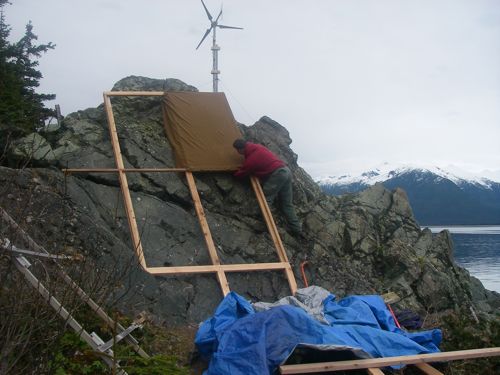We moved ahead briskly on installing the new solar array over the weekend, despite stiff competition from other projects. The correct connectors arrived Friday (see I Lack Connections!). That had been our bottleneck.
While waiting for them, I built the frame out of cedar. That came together smoothly, even though I abandoned my design somewhere along the way. As a result, I replaced a crosswise cushion stringer that was too short for the free-styling I’d engaged in with an extra long one. I decided to leave it long until after we installed the panels. Likely, it’ll support the beginning of the wire run to the cabin.
I disconnected and dismantled the old PV array Saturday evening. We set the new frame in place and braced it so that it would hold the new panels securely.

Comparison of panel sizes, old (front) and new (back). We use dry erase markers to identify panels and positioning (Photo: Michelle L. Zeiger).
The trickiest part of installing the panels proved to be securing covers on them so that they don’t generate power, which would make the wiring “live” while I worked on it. That could be bad. Blankets and cardboard look like they’ll do the trick; the blankets are better, but we’re about one short of the right size.
One nasty surprise: the company’s documentation clearly state that drilling the frames voids the warranty. I discovered that my bargain solar panels had been installed before, and whoever did that drilled holes in the frames! My panels apparently came with the warranty pre-voided, thank you very much! Luckily, PV panel warranties are excellent precisely because they’re almost never needed.
We installed and bolted the two top panels on Sunday. Today I hope to get the lower two up and everything connected.
Then we’ll unveil the panels (as it were) and our new PV array will go live!



Whats the open circuit Voltage of the panels?
I wouldn’t expect a 24V panel to get up above about 40V open circuit which isn’t enough to be concerned about. It might give you a little shock like a static discharge but it’s not enough to endanger you (unless you work at it, wet or broken skin directly across your heart and you might manage to hurt yourself).
If you’re really concerned; shorting the output will collapse the voltage and be a lot easier than trying to work with a cover over the panel.
Shorting is typically a bad thing to do to most power supplies but solar panels don’t mind. The Voltage collapses and they just turn the sunlight into heat (which it would have been anyway if the solar panel hadn’t turned it into electricity first).
Skvez, thanks, but it’s all academic now, we got the panels up.
I’ve gotten plenty of advice over the years about which voltages matter and which ones don’t. I recall a friend calmly telling me that he doesn’t worry about his toddler playing with household outlets, because the worst that could happen would be that she’d get a good jolt and learn not to do it again. Since then, I do my own research and use my own judgment when it comes to electricity. That usually means following all manufacturers’ recommendations, and treating even low voltages as potentially lethal. I figure that may make things a little more difficult sometimes, but no one I care about will end up hurt. Besides which, treating live solar panels casually tends to lead to handling other electrical situations casually. I’ve known a lot of professional electricians who died making dumb mistakes.
The bottom line: the company that made the panels recommended keeping them covered until we’d made all the connections, and that’s what we did.